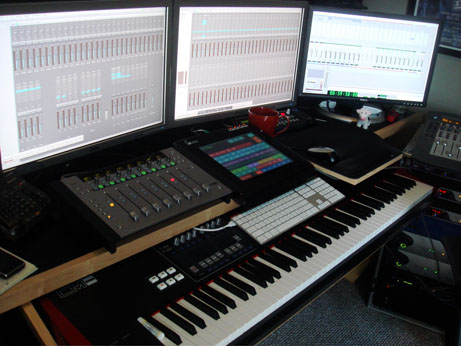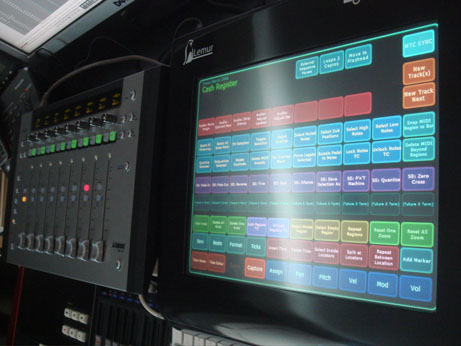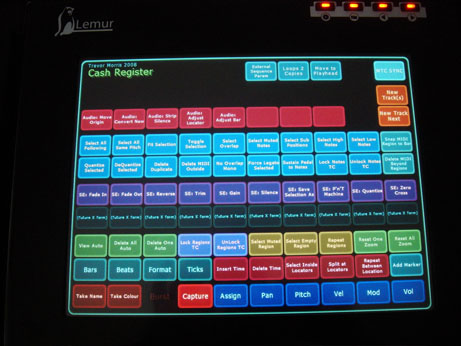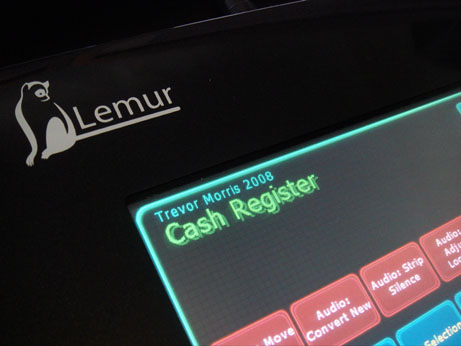|
|

|
|
|

|
|
|
|
Trevor Morris’ background in music composition began in Toronto where he made a name for
himself penning the music for TV and radio commercials, but he soon outgrew the medium…
“I wanted to expand my ability to express myself musically”, he explains. “This meant longer formats
and ultimately led to my move to Los Angeles in the year 2000.”
It turned out to be a great decision as Trevor now works alongside and shares studio space with
the legendary composer Hans Zimmer at his Remote Control facility. Zimmer has composed for
movies like Rain Man, Gladiator, The Lion King, Pearl Harbour and The Da Vinci Code and has won
a Grammy, Oscar, and two Golden Globes (among many other awards) along the way. He is also
well regarded for his love of technology and, in Trevor, has found someone just as passionate
about how technology can impact on music making.
“I have been collecting synths since I was a kid”, explains Morris. “I still have one of the original early serial
numbered Super Jupiter and programmers. There are only a few people that I know or have worked
with in LA who really dig technology and what it can do to aid in making Film music, but Hans’ influence
is definitely right up there”.
Unsurprisingly then, they keep their set-ups well stocked with the latest gear…
“Yes, we are pretty tech savvy and into all things music and technology at Remote Control. Hans is really
the pioneer, but Hans and I often talked about how the mouse is the enemy of creativity, and that there
has to be a better way. We have 10 fingers yet rarely use them. This notion sort of sent me out on a mission
to find new and exciting ways to express music, which led me to the Lemur.”
|

|

|

|

|
So what was it that drew him to the Lemur in the first place?
“Well there is nothing else like it on the market,” he explains. “I have had every type of controller there is
and they all do different things, but nothing out there does what the Lemur offers. It jumped out at me
as a must have device for my studio.”
Morris is using the Lemur in a variety of situations – from writing to recording – and is finding
more uses for it all the time… “The deeper you dig the more the scope of the Lemur opens up,” he explains.
“I have so many ideas for it – if only I didn’t have to write music all day [laughs]”.
He then goes on to reveal a specific and quite detailed use at a recent percussion recording session…
“I recorded my own custom percussion Library on one of LA’s biggest scoring stages: We recorded the
Decca Tree LCR [microphone recording pattern], close mics, mid mics, far mics, surround mics, and
speaker recorded ‘mix back’ pair. All of these were available on MIDI controllers to tailor each percussion
sound to be as roomy or dry, or as stereo or surround as I wanted. The problem is it takes 13 MIDI
controller numbers, and most fader packages only have eight, or if they do have more they don’t have
scribble strips to tell me what things are doing. With the Lemur, though, I get to have all my MIDI cc’s
up at once and really ‘mix’ the drums into the room in a meaningful and intuitive way, rather than the
lumpy work-rounds I have been using up until now. And this is just the tip of the iceberg!”
Morris is very opinionated when it comes to technology getting in the way of making music but believes that the Lemur changes all that.
“It has really bridged the intuitive nature of writing music, similar to you just playing the notes your
brain wants you to on a piano”, he says. “This is a big deal since there are so many parts of writing music
on computers that impede your ideas, and the idea is king. The Lemur allows for totally customized
ways of working, and we all work differently which is, of course, the point. Only an open-ended system
like the Lemur can achieve this level of custom control”.
So is there one feature on the Lemur that Trevor specifically likes? Difficult question!
“Well, if you can think it, it can do it!” he replies. “Like wanting to have multiple kinds of delays available
on, say, [Spectrasonics Stylus] RMX like 8th, 16th, dotted, triplet, reverb through, reverse, whatever…
It’s like instant gratification for taking otherwise stock loops and sounds (which I generally find always
slightly the wrong thing for what I need) and just rolling with a creative idea of changing it”.
So while the Lemur has undoubtedly scored a hit with Trevor, how would he like to see it – and
technology in general – developed?
“Let me dig into it deeper, but I will be first in line with gentle suggestions”, he laughs. “Tools are tools
and ideas are Ideas”, he continues. “Technology can greatly influence the way you work and look at
your world. Production values are more important than ever, and it’s important to me that things sound
fresh and not stock and stale. When I worked with Brian Transeau on Stealth I went over to his studio
and he played the opening cue of the movie. It had this incredible sound that wasn’t synthetic or organic.
He leant over to me in mid play back and says: ‘dude, that’s all code’, meaning he had written the
first bit of the movie entirely in computer code (CSound, I think it was). Now that’s a bit further than my
brain will go, but what an interesting way to start a movie about an A.I. plane? No amount of sitting at
the piano is getting you to that end result”.
But the bottom line is that with or without technology there is one important factor in all good
music…
“Melody is King – this is my number one in the 10 commandments of music. But beyond that is what
you do with it and where you take it – that’s where technology comes into play.”
So what does Trevor have planned next?
“I am trying to create two exact duplicate studios, which is kind of the white elephant of technical feats.
I am close to being able to truly open a sequence in two different studios seamlessly – just a semantic
pain in the ass! And I guess I will also need a second Lemur!”
|
|
|
|
|
|
Go back to Artists
|
|
|
|
|




